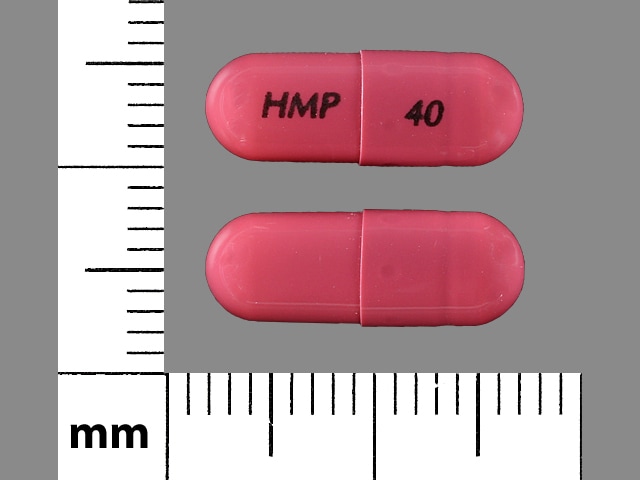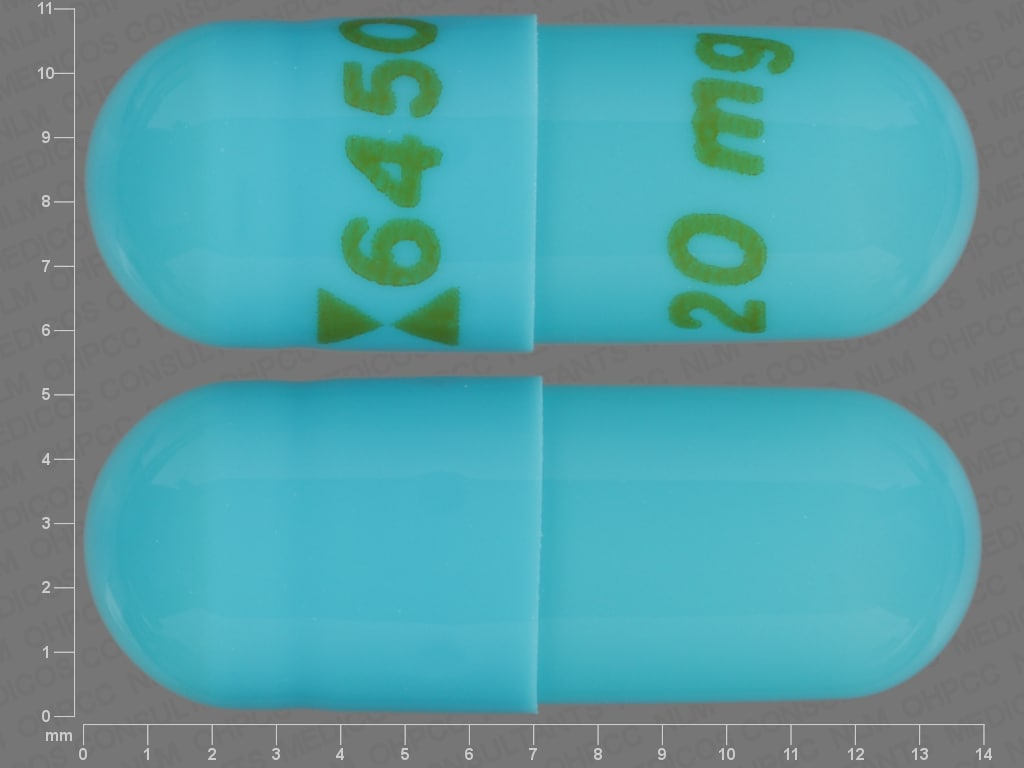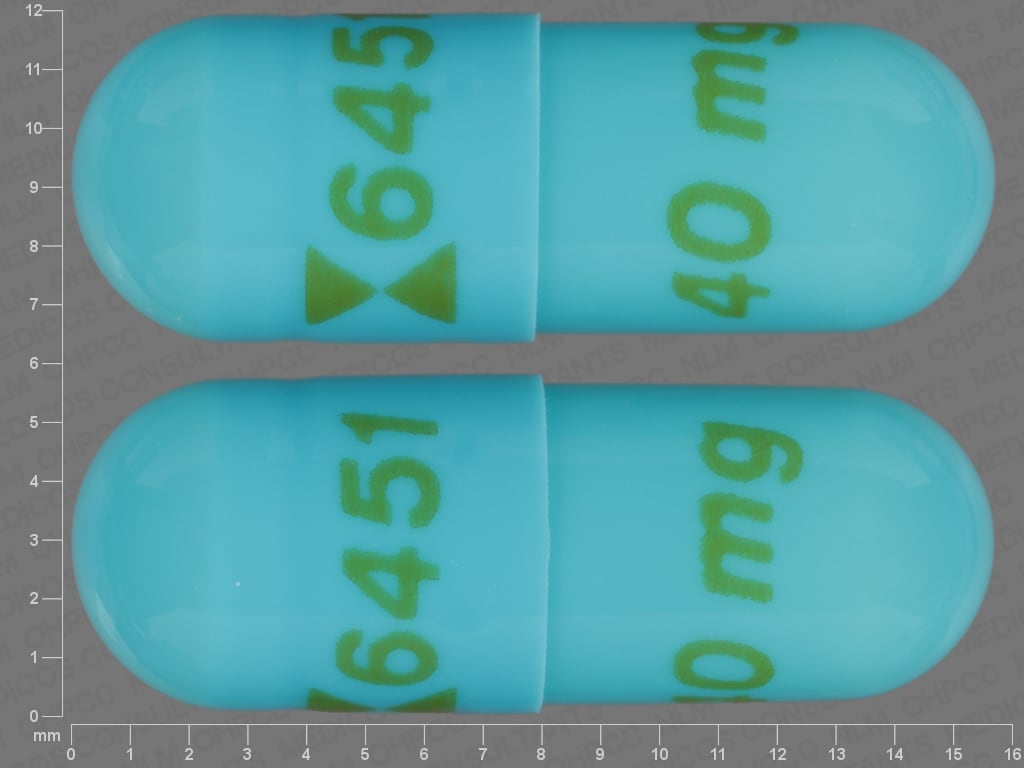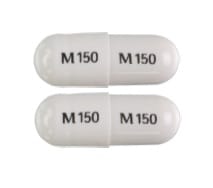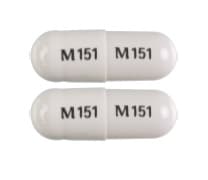Dosage Forms
Excipient information presented when available (limited, particularly for generics); consult specific product labeling. [DSC] = Discontinued product
Capsule Delayed Release, Oral, as magnesium [strength expressed as base]:
GoodSense Esomeprazole: 20 mg [gluten free; contains brilliant blue fcf (fd&c blue #1)]
NexIUM: 20 mg, 40 mg [contains brilliant blue fcf (fd&c blue #1), fd&c red #40, fd&c yellow #10 (quinoline yellow)]
NexIUM 24HR: 20 mg [contains brilliant blue fcf (fd&c blue #1), fd&c red #40]
NexIUM 24HR Clear Minis: 20 mg [contains corn starch, fd&c blue #2 (indigotine), fd&c blue #2 aluminum lake, fd&c red #40]
Generic: 20 mg, 40 mg
Capsule Delayed Release, Oral, as strontium:
Generic: 24.65 mg [DSC], 49.3 mg [DSC]
Kit, Oral, as magnesium [strength expressed as base]:
Esomep-EZS: 20 mg [contains brilliant blue fcf (fd&c blue #1), sodium benzoate]
Packet, Oral, as magnesium [strength expressed as base]:
NexIUM: 2.5 mg (30 ea); 5 mg (30 ea); 10 mg (30 ea); 20 mg (30 ea); 40 mg (30 ea)
Solution Reconstituted, Intravenous, as sodium [strength expressed as base]:
NexIUM I.V.: 40 mg (1 ea) [contains edetate disodium]
Generic: 20 mg (1 ea [DSC]); 40 mg (1 ea)
Solution Reconstituted, Intravenous, as sodium [strength expressed as base, preservative free]:
Generic: 40 mg (1 ea)
Tablet Delayed Release, Oral, as magnesium [strength expressed as base]:
NexIUM 24HR: 20 mg [contains fd&c blue #2 aluminum lake, fd&c red #40 aluminum lake]
Pharmacology
Mechanism of Action
Proton pump inhibitor suppresses gastric acid secretion by inhibition of the H+/K+-ATPase in the gastric parietal cell. Esomeprazole is the S-isomer of omeprazole.
Pharmacokinetics/Pharmacodynamics
Distribution
Vdss: 16 L
Metabolism
Hepatic via CYP2C19 primarily and (to a lesser extent) via 3A4 to hydroxy, desmethyl, and sulfone metabolites (all inactive)
Excretion
Urine (80%, primarily as inactive metabolites; <1% as active drug); feces (20%)
Clearance (with repeated dosing):
Children 1 to 5 years: 6 to 19.44 L/hour (Zhao 2006)
Children 6 to 11 years: 7.84 to 9.22 L/hour (Zhao 2006)
Children ≥12 years and Adolescents ≤17 years: 8.36 to 15.88 L/hour (Li 2006)
Time to Peak
Oral:
Infants: Median: 3 hours
Children 1 to 5 years: 1.33 to 1.44 hours (Zhao 2006)
Children 6 to 11 years: 1.75 to 1.79 hours (Zhao 2006)
Children ≥12 years and Adolescents ≤17 years: 1.96 to 2.04 hours (Li 2006)
Adults: 1.5 to 2 hours
Half-Life Elimination
Infants: 0.93 hours
Children 1 to 5 years: 0.42 to 0.74 hours (Zhao 2006)
Children 6 to 11 years: 0.73 to 0.88 hours (Zhao 2006)
Children ≥12 years and Adolescents ≤17 years: 0.82 to 1.22 hours (Li 2006)
Adults: ~1 to 1.5 hours
Protein Binding
97%
Use in Specific Populations
Special Populations: Hepatic Function Impairment
AUC was 2 to 3 times higher in patients with severe hepatic impairment.
Special Populations: Elderly
AUC and Cmax were increased by 25% and 18%, respectively, following administration of esomeprazole magnesium.
Special Populations: Gender
AUC and Cmax were 13% higher in women than men following administration of esomeprazole magnesium.
Use: Labeled Indications
Oral:
Esomeprazole magnesium and esomeprazole strontium:
Gastroesophageal reflux disease (Rx only):
Healing of erosive esophagitis: Short-term (4 to 8 weeks) treatment of erosive esophagitis
Maintenance of healing of erosive esophagitis: Maintaining symptom resolution and healing of erosive esophagitis
Symptomatic gastroesophageal reflux disease: Short-term (4 to 8 weeks) treatment of symptomatic gastroesophageal reflux disease (GERD)
Helicobacter pylori eradication (Rx only): As part of a multidrug regimen for Helicobacter pylori eradication in patients with duodenal ulcer disease (active or history of within the past 5 years)
Risk reduction of nonsteroidal anti-inflammatory drug-associated gastric ulcer (Rx only): Prevention of gastric ulcers associated with continuous NSAID therapy in patients at risk (age ≥60 years and/or history of gastric ulcer)
Pathological hypersecretory conditions, including Zollinger-Ellison syndrome (Rx only): Treatment (long-term) of pathological hypersecretory conditions including Zollinger-Ellison syndrome
Esomeprazole magnesium:
Heartburn (OTC labeling): Treatment of frequent heartburn (≥2 days per week).
IV: Esomeprazole sodium:
Gastroesophageal reflux disease (Rx only): Short-term (≤10 days) treatment of gastroesophageal reflux disease (GERD) with erosive esophagitis in pediatric patients 1 month to 17 years of age and adults when oral therapy is not possible or appropriate
Risk reduction of ulcer rebleeding postprocedure (Rx only): Decrease the risk of rebleeding postendoscopy for acute bleeding gastric or duodenal ulcers in adults
Use: Off Label
Barrett esophagusbyes
Data from a meta-analysis of observational studies evaluating acid suppressive therapy and the risk of esophageal adenocarcinoma or high-grade dysplasia in patients with Barrett esophagus showed that proton pump inhibitors were associated with a reduction in the risk of esophageal adenocarcinoma and high-grade dysplasia associated with Barrett esophagus; a longer duration of PPI use was associated with a greater protective effect Singh 2014. The use of esomeprazole in combination with aspirin for the treatment of Barrett esophagus, including preventing neoplastic progression, has also been reported Jankowski 2018.
Guidelines from the American College of Gastroenterology for the diagnosis and management of Barrett esophagus and a position statement from the American Gastroenterological Association on the management of Barrett esophagus recommend the use of proton pump inhibitors in the management of Barrett esophagus.
Dyspepsiaayes
Data from two randomized, double-blinded, placebo-controlled trials supports the use of esomeprazole for the treatment of dyspepsia Talley 2007, Van Zanten 2006. In addition, data from a systematic review support the use of esomeprazole for the treatment of patients with ulcer and reflux-like functional dyspepsia Pinto-Sanchez 2017.
Based on the American College of Gastroenterology (ACG) and Canadian Association of Gastroenterology (CAG) guidelines for the management of dyspepsia, the use of esomeprazole is effective and recommended treatment for dyspepsia and functional dyspepsia in patients <60 years of age who are H. pylori negative or who remain symptomatic after H. pylori eradication therapy ACG/CAG [Moayyedi 2017].
Stress ulcer prophylaxis in critically ill patientsyes
Based on the Surviving Sepsis Campaign International Guidelines for the Management of Severe Sepsis and Septic Shock, stress ulcer prophylaxis using a proton pump inhibitor or a histamine H2-receptor antagonist is recommended in sepsis or septic shock patients who have GI bleeding risk factors.
Treatment of NSAID-induced gastric ulcersa
Data from a multicenter, randomized, double-blind, parallel-group clinical trial supports the use of esomeprazole in the treatment of NSAID-induced gastric ulcers Goldstein 2007.
Contraindications
Hypersensitivity (eg, anaphylaxis, anaphylactic shock, angioedema, bronchospasm, acute interstitial nephritis, urticaria) to esomeprazole, other substituted benzimidazole proton pump inhibitors, or any component of the formulation; concomitant use with products that contain rilpivirine.
OTC labeling: When used for self-medication (OTC), do not use if you have trouble or pain when swallowing food; vomiting with blood, or bloody or black stools; heartburn with light-headedness, dizziness, or sweating; chest pain or shoulder pain with shortness of breath, sweating, pain spreading to arms, neck or shoulders, or light-headedness; frequent chest pain.
Dosage and Administration
Dosing: Adult
Note: All dosing is expressed in terms of esomeprazole base, regardless of the salt associated with the dosing information. Esomeprazole strontium 24.65 mg is equivalent to 20 mg of esomeprazole base; esomeprazole strontium 49.3 mg is equivalent to 40 mg of esomeprazole base.
Barrett esophagus (off-label use): Oral: Utilize standard doses (20 or 40 mg) once daily (Shaheen 2016; Singh 2014; Spechler 2011); poorly controlled reflux symptoms or esophagitis may require twice daily dosing (Shaheen 2016). The use of 40 mg twice daily (in combination with aspirin) also has been reported (Jankowski 2018).
Dyspepsia (off-label use): Oral: 40 mg once daily for up to 8 weeks (Talley 2007; Pinto-Sanchez 2017; van Zanten 2006).
Erosive esophagitis (healing): Oral: Esomeprazole magnesium, esomeprazole strontium: Initial: 20 to 40 mg once daily for 4 to 8 weeks; if incomplete healing, may continue for an additional 4 to 8 weeks; maintenance: 20 mg once daily (controlled studies did not extend beyond 6 months)
Heartburn (OTC labeling): 20 mg once daily for 14 days (maximum: 20 mg/day); treatment may be repeated after 4 months if needed
Helicobacter pylori eradication: Oral:
American College of Gastroenterology guidelines (Chey 2007; Chey 2017):
Clarithromycin triple regimen: 20 to 40 mg twice daily in combination with clarithromycin 500 mg twice daily and either amoxicillin 1 g twice daily or metronidazole 500 mg 3 times daily; continue regimen for 14 days. Note: Avoid use of clarithromycin triple therapy in patients with risk factors for macrolide resistance (eg, prior macrolide exposure, local clarithromycin resistance rates ≥15%, eradication rates with clarithromycin-based regimens ≤85%) (ACG [Chey 2017]; Fallone 2016).
Bismuth quadruple regimen: 20 mg twice daily in combination with tetracycline 500 mg 4 times daily, metronidazole 250 mg 4 times daily or 500 mg 3 or 4 times daily, and either bismuth subcitrate 120 to 300 mg 4 times daily or bismuth subsalicylate 300 mg 4 times daily; continue regimen for 10 to 14 days.
Concomitant regimen: 20 mg twice daily in combination with amoxicillin 1 g twice daily, clarithromycin 500 mg twice daily, and either metronidazole or tinidazole 500 mg twice daily; continue regimen for 10 to 14 days.
Sequential regimen: 20 mg twice daily plus amoxicillin 1 g twice daily for 5 to 7 days; then continue esomeprazole along with clarithromycin 500 mg twice daily, and either metronidazole or tinidazole 500 mg twice daily for 5 to 7 days.
Hybrid regimen: 20 mg twice daily plus amoxicillin 1 g twice daily for 7 days; then continue esomeprazole and amoxicillin along with clarithromycin 500 mg twice daily, and either metronidazole or tinidazole 500 mg twice daily for 7 days.
Levofloxacin triple regimen: 20 mg twice daily in combination with amoxicillin 1 g twice daily and levofloxacin 500 mg once daily; continue regimen for 10 to 14 days.
Manufacturer's labeling: Dosing in the prescribing information may not reflect current clinical practice. Esomeprazole magnesium, esomeprazole strontium: 40 mg once daily
Pathological hypersecretory conditions (Zollinger-Ellison syndrome): Oral: Esomeprazole magnesium, esomeprazole strontium: 40 mg twice daily; adjust regimen to individual patient needs; doses up to 240 mg daily have been administered
Prevention of NSAID-induced gastric ulcers: Oral: Esomeprazole magnesium, esomeprazole strontium: 20 to 40 mg once daily for up to 6 months; Note: 40 mg daily did not show additional benefit over 20 mg daily in clinical trials.
Prevention of recurrent gastric or duodenal ulcer bleeding postendoscopy: IV: 80 mg over 30 minutes, followed by 8 mg/hour continuous infusion for a total of 72 hours, then 40 mg orally once daily for 27 additional days (Sung 2009) or may follow continuous infusion with any single daily-dose oral proton pump inhibitor (PPI) for a duration dictated by the underlying etiology (Barkun 2010). Note: The use of intermittent PPIs was found to be comparable with the use of continuous infusion PPIs in patients with high-risk endoscopic findings and may be preferred (Sachar 2014).
Symptomatic gastroesophageal reflux: Oral: Esomeprazole magnesium, esomeprazole strontium: 20 mg once daily for 4 weeks; may consider an additional 4 weeks of treatment if symptoms do not resolve
Treatment of GERD (short-term): IV: 20 mg or 40 mg once daily. Note: Indicated only in cases where oral therapy is inappropriate or not possible; safety/efficacy ≥10 days has not been established.
Treatment of NSAID-induced gastric ulcers (off-label use): Oral: Esomeprazole magnesium: 20 mg once daily for 8 weeks (Goldstein 2007)
Discontinuation of therapy: Oral: Some experts recommend a step-down approach in order to avoid worsening or rebound symptoms. One recommendation is to decrease the dose by 50% over 2 weeks to 4 weeks. If the patient is already on the lowest possible dose, alternate day therapy may be considered. If symptoms worsen during treatment or after discontinuation, patient should be re-evaluated (Kim 2018).
Dosing: Geriatric
Refer to adult dosing.
Dosing: Pediatric
Erosive esophagitis associated with GERD:
Oral:
Infants:
3 to 5 kg: 2.5 mg once daily for up to 6 weeks.
>5 to 7.5 kg: 5 mg once daily for up to 6 weeks.
>7.5 kg: 10 mg once daily for up to 6 weeks.
Children 1 to 11 years:
<20 kg: 10 mg once daily for 8 weeks.
≥20 kg: 10 or 20 mg once daily for 8 weeks.
Children ≥12 years and Adolescents: 20 to 40 mg once daily for 4 to 8 weeks.
IV: Note: Indicated only in cases where oral therapy is inappropriate or not possible; safety and efficacy >10 days has not been established.
Infants: 0.5 mg/kg/dose once daily.
Children and Adolescents ≤17 years:
<55 kg: 10 mg once daily.
≥55 kg: 20 mg once daily.
GERD, symptomatic: Note: Guidelines recommend a 4- to 8-week treatment course; if improvement seen after 4 to 8 weeks, consider possible wean; if no response after 4 to 8 weeks, reevaluate diagnosis and consider referral to pediatric GI specialist (NASPGHAN/ESPGHAN [Rosen 2018]).
Weight-based dosing: Infants, Children, and Adolescents: Oral: 0.7 to 3.3 mg/kg/day (AAP [Lightdale 2013]); maximum dose: 40 mg/dose (NASPGHAN/ESPGHAN [Rosen 2018]).
Fixed dosing (NASPGHAN/ESPGHAN [Rosen 2018]): Children and Adolescents: Oral:
<20 kg: 10 mg once daily.
≥20 kg: 20 mg once daily.
Helicobacter pylori eradication (NASPGHAN/ESPGHAN [Jones 2017]): Children and Adolescents: Oral: Note: Usual duration of therapy is 14 days as part of triple therapy; use in combination with 2 antimicrobials (eg, clarithromycin, metronidazole, amoxicillin); preferred agents determined by susceptibility. Bismuth may be added to regimens as an alternative if resistance is present or susceptibility is unknown.
15 to <25 kg: 20 mg twice daily.
25 to 34 kg: 30 mg twice daily.
>34 kg: 40 mg twice daily.
Discontinuation of therapy: Oral: Based on experience in adults, some experts recommend a step-down approach in order to avoid worsening or rebound symptoms. One recommendation is to decrease the dose by 50% over 2 to 4 weeks. If the patient is already on the lowest possible dose, alternate day therapy may be considered. If symptoms worsen during treatment or after discontinuation, patient should be reevaluated (Kim 2018).
Reconstitution
Granules for oral administration: Empty the 2.5 mg or 5 mg packet into a container with 5 mL of water or empty the 10 mg, 20 mg, or 40 mg packet into a container with 15 mL of water and stir; leave 2-3 minutes to thicken.
Powder for injection:
For IV injection (≥3 minutes): Adults: Reconstitute powder with 5 mL NS.
For IV infusion (10 to 30 minutes): Initially reconstitute powder with 5 mL of NS, LR, or D5W, then further dilute to a final volume of 50 mL.
For IV infusion (loading dose and continuous infusion): Prepare the 80 mg loading dose by reconstituting two 40 mg vials with NS (5 mL each); the contents of the two vials should then be further diluted in NS 100 mL. To prepare the continuous infusion, also reconstitute two 40 mg vials with NS (5 mL each); the contents of the two vials should then be further diluted in NS 100 mL.
Administration
Oral:
Capsule: Swallow whole and take at least 1 hour before eating (best if taken before breakfast). Capsule can be opened and contents mixed with 1 tablespoon of applesauce. Swallow immediately; mixture should not be chewed or warmed. For patients with difficulty swallowing, use of granules may be more appropriate.
Granules: Empty the 2.5 mg or 5 mg packet into a container with 5 mL of water or the 10 mg, 20 mg, or 40 mg packet into a container with 15 mL of water and stir; leave 2 to 3 minutes to thicken. Stir and drink within 30 minutes. If any medicine remains after drinking, add more water, stir and drink immediately.
Tablet: Swallow whole; do not crush or chew; administer with a full glass of water before breakfast in the morning.
Tablet [Canadian product]: Swallow whole with water or may be dispersed in a half a glass of noncarbonated water. Stir until tablets disintegrate, and drink the liquid with pellets immediately or within 30 minutes. Do not chew or crush pellets. After drinking, rinse glass with water and drink.
IV: Flush line prior to and after administration with NS, LR, or D5W.
Treatment of GERD: May be administered by injection (≥3 minutes), or intermittent infusion (10 to 30 minutes)
Prevention of recurrent gastric or duodenal ulcer bleeding postendoscopy: Administer the loading dose over 30 minutes, followed by the continuous infusion at a rate of 8 mg/hour over 71.5 hours (adjust rate of continuous infusion in patients with hepatic dysfunction)
Nasogastric tube:
Capsule: Open capsule and place intact granules into a 60 mL catheter-tip syringe; mix with 50 mL of water. Replace plunger and shake vigorously for 15 seconds. Ensure that no granules remain in syringe tip. Do not administer if pellets dissolve or disintegrate. Use immediately after preparation. After administration, flush nasogastric tube with additional water.
Granules: Delayed release oral suspension granules can also be given by nasogastric or gastric tube. If using a 2.5 mg or 5 mg packet, first add 5 mL of water to a catheter-tipped syringe, then add granules from packet. If using a 10 mg, 20 mg, or 40 mg packet, first add 15 mL of water to a catheter-tipped syringe, then add granules from packet. Shake the syringe, leave 2 to 3 minutes to thicken. Shake the syringe and administer through nasogastric or gastric tube (size 6 French or greater) within 30 minutes. Refill the syringe with equal amount (5 mL or 15 mL) of water, shake and flush nasogastric/gastric tube.
Tablet [Canadian product]: Dispersed tablets can also be given by nasogastric tube (size 8 to 20 French) using a 25 to 60 mL disposable syringe. Disperse tablet in 50 mL of water. After administration, flush with additional 25 to 50 mL of water to clear the syringe and tube. In larger nasogastric feeding tubes (ie, size 14 French or greater), the dispersion volume may be reduced to 25 mL.
Dietary Considerations
Take at least 1 hour before meals; best if taken before breakfast.
Storage
Capsules:
Esomeprazole magnesium: Store at 25°C (77°F); excursions permitted to 15°C to 30°C (59°F to 86°F).
Esomeprazole strontium: Store at 20°C to 25°C (68°F to 77°F); excursions permitted to 15°C to 30°C (59°F to 86°F).
Granules: Store at 25°C (77°F); excursions permitted to 15°C to 30°C (59°F to 86°F).
Powder for injection: Store at 25°C (77°F); excursions permitted to 15°C to 30°C (59°F to 86°F). Protect from light. Per the manufacturer, following reconstitution, solution for injection prepared in NS, and solution for infusion prepared in NS or LR should be used within 12 hours; solution for infusion prepared in D5W should be used within 6 hours. Refrigeration is not required following reconstitution.
Additional stability data: Following reconstitution, solutions for infusion prepared in D5W, NS, or LR in PVC bags are chemically and physically stable for 48 hours at room temperature (25°C) and for at least 120 hours under refrigeration (4°C) (Kupiec 2008).
Tablets: Store at 20°C to 25°C (68°F to 77°F).
Esomeprazole Images
Drug Interactions
Acalabrutinib: Proton Pump Inhibitors may decrease the serum concentration of Acalabrutinib. Avoid combination
Amphetamine: Proton Pump Inhibitors may increase the absorption of Amphetamine. Monitor therapy
Atazanavir: Proton Pump Inhibitors may decrease the serum concentration of Atazanavir. Management: See full drug interaction monograph for details. Consider therapy modification
Bisphosphonate Derivatives: Proton Pump Inhibitors may diminish the therapeutic effect of Bisphosphonate Derivatives. Monitor therapy
Bosutinib: Proton Pump Inhibitors may decrease the serum concentration of Bosutinib. Management: Consider alternatives to proton pump inhibitors, such as short-acting antacids or histamine-2 receptor antagonists. Administer alternative agents more than 2 hours before or after bosutinib. Consider therapy modification
Capecitabine: Proton Pump Inhibitors may diminish the therapeutic effect of Capecitabine. Monitor therapy
Cefditoren: Proton Pump Inhibitors may decrease the serum concentration of Cefditoren. Management: If possible, avoid use of cefditoren with proton pump inhibitors (PPIs). Consider alternative methods to minimize/control acid reflux (eg, diet modification) or alternative antimicrobial therapy if use of PPIs can not be avoided. Consider therapy modification
Cefpodoxime: Proton Pump Inhibitors may decrease the serum concentration of Cefpodoxime. Monitor therapy
Cefuroxime: Proton Pump Inhibitors may decrease the absorption of Cefuroxime. Avoid combination
Cilostazol: Esomeprazole may increase serum concentrations of the active metabolite(s) of Cilostazol. Esomeprazole may increase the serum concentration of Cilostazol. Monitor therapy
Citalopram: Esomeprazole may increase the serum concentration of Citalopram. Monitor therapy
Clopidogrel: Esomeprazole may diminish the antiplatelet effect of Clopidogrel. Esomeprazole may decrease serum concentrations of the active metabolite(s) of Clopidogrel. Management: Clopidogrel prescribing information recommends avoiding concurrent use with esomeprazole. Rabeprazole or pantoprazole may be lower-risk alternatives to esomeprazole. Consider therapy modification
CYP2C19 Inducers (Moderate): May decrease the serum concentration of CYP2C19 Substrates (High risk with Inducers). Monitor therapy
CYP2C19 Inducers (Strong): May increase the metabolism of CYP2C19 Substrates (High risk with Inducers). Management: Consider an alternative for one of the interacting drugs. Some combinations may be specifically contraindicated. Consult appropriate manufacturer labeling. Consider therapy modification
Cysteamine (Systemic): Proton Pump Inhibitors may diminish the therapeutic effect of Cysteamine (Systemic). Monitor therapy
Dabrafenib: May decrease the serum concentration of CYP2C19 Substrates (High risk with Inducers). Management: Seek alternatives to the CYP2C19 substrate when possible. If concomitant therapy cannot be avoided, monitor clinical effects of the substrate closely (particularly therapeutic effects). Consider therapy modification
Dacomitinib: Proton Pump Inhibitors may decrease the serum concentration of Dacomitinib. Management: Avoid concurrent use of dacomitinib with proton pump inhibitors. Antacids may be used. Histamine H2-receptor antagonists (HR2A) may be used if dacomitinib is given at least 6 hours before or 10 hours after the H2RA. Avoid combination
Dasatinib: Proton Pump Inhibitors may decrease the serum concentration of Dasatinib. Management: Antacids (taken 2 hours before or after dasatinib administration) can be used in place of the proton pump inhibitor if some acid-reducing therapy is needed. Avoid combination
Delavirdine: Proton Pump Inhibitors may decrease the serum concentration of Delavirdine. Management: Chronic therapy with proton pump inhibitors (PPIs) should be avoided in patients treated with delavirdine. The clinical significance of short-term PPI therapy with delavirdine is uncertain, but such therapy should be undertaken with caution. Avoid combination
Dexmethylphenidate: Proton Pump Inhibitors may increase the absorption of Dexmethylphenidate. Specifically, proton pump inhibitors may interfere with the normal release of drug from the extended-release capsules (Focalin XR brand), which could result in both increased absorption (early) and decreased delayed absorption. Monitor therapy
Dextroamphetamine: Proton Pump Inhibitors may increase the absorption of Dextroamphetamine. Specifically, the dextroamphetamine absorption rate from mixed amphetamine salt extended release (XR) capsules may be increased in the first hours after dosing. Monitor therapy
Dichlorphenamide: OAT1/3 Inhibitors may increase the serum concentration of Dichlorphenamide. Monitor therapy
Doxycycline: Proton Pump Inhibitors may decrease the bioavailability of Doxycycline. Monitor therapy
Enzalutamide: May decrease the serum concentration of CYP2C19 Substrates (High risk with Inducers). Conversely, concentrations of active metabolites may be increased for those drugs activated by CYP2C19. Management: Concurrent use of enzalutamide with CYP2C19 substrates that have a narrow therapeutic index should be avoided. Use of enzalutamide and any other CYP2C19 substrate should be performed with caution and close monitoring. Consider therapy modification
Erlotinib: Proton Pump Inhibitors may decrease the serum concentration of Erlotinib. Avoid combination
Fluconazole: May increase the serum concentration of Proton Pump Inhibitors. Monitor therapy
Gefitinib: Proton Pump Inhibitors may decrease the serum concentration of Gefitinib. Management: Avoid use of proton pump inhibitors (PPIs) with gefitinib when possible. If required, administer gefitinib 12 hours after administration of the PPI or 12 hours before the next dose of the PPI. Consider therapy modification
Indinavir: Proton Pump Inhibitors may decrease the serum concentration of Indinavir. Monitor therapy
Iron Preparations: Proton Pump Inhibitors may decrease the absorption of Iron Preparations. Exceptions: Ferric Carboxymaltose; Ferric Citrate; Ferric Derisomaltose; Ferric Gluconate; Ferric Hydroxide Polymaltose Complex; Ferric Pyrophosphate Citrate; Ferumoxytol; Iron Dextran Complex; Iron Sucrose. Monitor therapy
Itraconazole: Proton Pump Inhibitors may increase the serum concentration of Itraconazole. Proton Pump Inhibitors may decrease the serum concentration of Itraconazole. Management: Exposure to Tolsura brand itraconazole may be increased by PPIs; consider itraconazole dose reduction. Exposure to Sporanox brand itraconazole capsules may be decreased by PPIs. Give Sporanox brand itraconazole at least 2 hrs before or 2 hrs after PPIs Consider therapy modification
Ketoconazole (Systemic): Proton Pump Inhibitors may decrease the absorption of Ketoconazole (Systemic). Ketoconazole (Systemic) may increase the serum concentration of Proton Pump Inhibitors. Management: Administer ketoconazole with an acidic beverage, such as non-diet cola, to increase gastric acidity and improve absorption if concomitant use with proton pump inhibitors is necessary. Consider therapy modification
Ledipasvir: Proton Pump Inhibitors may decrease the serum concentration of Ledipasvir. Management: PPI doses equivalent to omeprazole 20 mg or lower may be given with ledipasvir under fasted conditions. Administration with higher doses of PPIs, 2 hours after a PPI, or in combination with food and PPIs may reduce ledipasvir bioavailability. Consider therapy modification
Lumacaftor and Ivacaftor: May decrease the serum concentration of CYP2C19 Substrates (High risk with Inducers). Monitor therapy
Lumacaftor and Ivacaftor: May decrease the serum concentration of Proton Pump Inhibitors. Monitor therapy
Mesalamine: Proton Pump Inhibitors may diminish the therapeutic effect of Mesalamine. Proton pump inhibitor-mediated increases in gastrointestinal pH may cause the premature release of mesalamine from specific sustained-release mesalamine products. Management: Consider avoiding concurrent administration of high-dose proton pump inhibitors (PPIs) with sustained-release mesalamine products. Consider therapy modification
Methotrexate: Proton Pump Inhibitors may increase the serum concentration of Methotrexate. Monitor therapy
Methylphenidate: Proton Pump Inhibitors may increase the absorption of Methylphenidate. Specifically, proton pump inhibitors may interfere with the normal release of drug from the extended-release capsules (Ritalin LA brand), which could result in both increased absorption (early) and decreased delayed absorption. Monitor therapy
Multivitamins/Minerals (with ADEK, Folate, Iron): Proton Pump Inhibitors may decrease the serum concentration of Multivitamins/Minerals (with ADEK, Folate, Iron). Specifically, the absorption of iron may be decreased. Monitor therapy
Mycophenolate: Proton Pump Inhibitors may decrease the serum concentration of Mycophenolate. Specifically, concentrations of the active mycophenolic acid may be reduced. Monitor therapy
Nelfinavir: Proton Pump Inhibitors may decrease serum concentrations of the active metabolite(s) of Nelfinavir. Proton Pump Inhibitors may decrease the serum concentration of Nelfinavir. Avoid combination
Neratinib: Proton Pump Inhibitors may decrease the serum concentration of Neratinib. Specifically, proton pump inhibitors may reduce neratinib absorption. Avoid combination
Nilotinib: Proton Pump Inhibitors may decrease the serum concentration of Nilotinib. Management: Avoid this combination when possible since separation of doses is not likely to be an adequate method of minimizing the interaction. Consider therapy modification
PAZOPanib: Proton Pump Inhibitors may decrease the serum concentration of PAZOPanib. Avoid combination
Pexidartinib: Proton Pump Inhibitors may decrease the serum concentration of Pexidartinib. Management: If acid-reduction is needed, consider administering an antacid 2 hours before or after pexidartinib, or administer pexidartinib 2 hours before or 10 hours after an H2 receptor antagonist. Avoid combination
Posaconazole: Proton Pump Inhibitors may decrease the serum concentration of Posaconazole. Consider therapy modification
Raltegravir: Proton Pump Inhibitors may increase the serum concentration of Raltegravir. Monitor therapy
RifAMPin: May decrease the serum concentration of Esomeprazole. Avoid combination
Rilpivirine: Proton Pump Inhibitors may decrease the serum concentration of Rilpivirine. Avoid combination
Riociguat: Proton Pump Inhibitors may decrease the serum concentration of Riociguat. Monitor therapy
Risedronate: Proton Pump Inhibitors may diminish the therapeutic effect of Risedronate. Proton Pump Inhibitors may increase the serum concentration of Risedronate. This applies specifically to use of delayed-release risedronate. Consider therapy modification
Saquinavir: Proton Pump Inhibitors may increase the serum concentration of Saquinavir. Monitor therapy
Secretin: Proton Pump Inhibitors may diminish the diagnostic effect of Secretin. Specifically, use of PPIs may cause a hyperresponse in gastrin secretion in response to secretin stimulation testing, falsely suggesting gastrinoma. Management: Avoid concomitant use of proton pump inhibitors (PPIs) and secretin, and discontinue PPIs several weeks prior to secretin administration, with the duration of separation determined by the specific PPI. See full monograph for details. Consider therapy modification
SORAfenib: Proton Pump Inhibitors may decrease the absorption of SORAfenib. Monitor therapy
St John's Wort: May decrease the serum concentration of Esomeprazole. Avoid combination
Tacrolimus (Systemic): Proton Pump Inhibitors may increase the serum concentration of Tacrolimus (Systemic). Management: Tacrolimus dose adjustment may be required. Rabeprazole, pantoprazole, or selected H2-receptor antagonists (i.e., ranitidine or famotidine) may be less likely to interact. Genetic testing may predict patients at highest risk. Consider therapy modification
Tipranavir: May decrease the serum concentration of Proton Pump Inhibitors. These data are derived from studies with Ritonavir-boosted Tipranavir. Monitor therapy
Velpatasvir: Proton Pump Inhibitors may decrease the serum concentration of Velpatasvir. Avoid combination
Vitamin K Antagonists (eg, warfarin): Esomeprazole may increase the serum concentration of Vitamin K Antagonists. Monitor therapy
Voriconazole: May increase the serum concentration of Proton Pump Inhibitors. Proton Pump Inhibitors may increase the serum concentration of Voriconazole. Monitor therapy
Test Interactions
Esomeprazole may falsely elevate serum chromogranin A (CgA) levels. The increased CgA level may cause false-positive results in the diagnosis of a neuroendocrine tumor. Temporarily stop esomeprazole ≥14 days prior to assessing CgA level; repeat level if initially elevated; use the same laboratory for all testing of CgA levels.
Adverse Reactions
Unless otherwise specified, percentages represent adverse reactions identified in clinical trials evaluating the oral formulation.
>10%: Central nervous system: Headache (2% to 11%)
1% to 10%:
Central nervous system: Irritability (infants: ≥5%), dizziness (intravenous: ≤3%; oral: <1%), vertigo (intravenous: ≤3%), drowsiness (children: 2%; adults: <1%)
Dermatologic: Pruritus (intravenous: 1%; oral: <1%)
Endocrine & metabolic: Altered thyroid hormone levels (increased thyroxine: ≤1%), decreased serum potassium (≤1%), decreased serum sodium (≤1%), decreased thyroid hormones (thyroxine: ≤1%), increased gastrin (≤1%), increased serum potassium (≤1%), increased serum sodium (≤1%), increased thyroid stimulating hormone level (≤1%), increased uric acid (≤1%)
Gastrointestinal: Flatulence (intravenous: 10%; oral: ≥1%), diarrhea (2% to 4%), abdominal pain (1% to 6%), nausea (intravenous: 6%; oral: ≥1% to 2%), vomiting (infants: 1% to ≥5%; adults: <1%), xerostomia (intravenous: 4%; oral: ≥1%), constipation (intravenous: 3%; oral: ≥1%)
Hematologic & oncologic: Quantitative disorders of platelets (≤1%)
Hepatic: Increased serum alkaline phosphatase (≤1%), increased serum alanine aminotransferase (≤1%), increased serum aspartate aminotransferase (≤1%)
Local: Injection site reaction (intravenous: 2% to 4%)
Renal: Increased serum creatinine (≤1%)
Respiratory: Cough (intravenous: 1%; oral: <1%), tachypnea (infants, oral: 1%)
Miscellaneous: Fever (intravenous: 4%; oral: <1%)
Frequency not defined:
Cardiovascular: Esophageal varices
Gastrointestinal: Barrett esophagus, duodenitis, esophageal stenosis, esophageal ulcer, esophagitis, gastritis, mucosal discoloration
Hematologic & oncologic: Benign polyp
Miscellaneous: Benign nodule
<1%, postmarketing, and/or case reports: Acne vulgaris, acute interstitial nephritis, aggressive behavior, ageusia, agitation, agranulocytosis, albuminuria, alopecia, altered sense of smell, anaphylactic shock, anaphylaxis, anemia, angioedema, anorexia, apathy, aphthous stomatitis, arthralgia, arthropathy, asthenia, back pain, blurred vision, bone fracture, bronchospasm, candidiasis (urogenital), cervical lymphadenopathy, change in bowel habits, chest pain, Clostridioides (formerly Clostridium) difficile-associated diarrhea, colitis (microscopic), confusion, conjunctivitis, cutaneous lupus erythematosus (including exacerbations), cyanocobalamin deficiency, cystitis, depression, dermatitis, diaphoresis, dysgeusia, dysmenorrhea, dyspepsia, dysphagia, dyspnea, dysuria, edema, enlargement of abdomen, epigastric pain, epistaxis, eructation, erythema multiforme, erythematous rash, exacerbation of arthritis, exacerbation of asthma, facial edema, fatigue, fibromyalgia syndrome, flu-like symptoms, flushing, frequent bowel movements, fungal infection, gastroenteritis, gastrointestinal candidiasis, gastrointestinal dysplasia, gastrointestinal hemorrhage, genital candidiasis, glycosuria, goiter, gynecomastia, hallucination, hematuria, hepatic encephalopathy, hepatic failure, hepatitis, hepatotoxicity (idiosyncratic) (Chalasani 2014), hernia of abdominal cavity, hiccups, hot flash, hyperbilirubinemia, hyperhidrosis, hypersensitivity reaction, hypertension, hypertonia, hyperuricemia, hypochromic anemia, hypoesthesia, hypomagnesemia (with or without hypocalcemia and/or hypokalemia), hyponatremia, impotence, increased appetite, increased thirst, insomnia, interstitial nephritis, jaundice, laryngeal edema, leukocytosis, leukopenia, maculopapular rash, malaise, melena, menstrual disease, migraine, mouth disease, muscle cramps, myalgia, myasthenia, nervousness, otalgia, otitis media, pain, pancreatitis, pancytopenia, paresthesia, pathological fracture due to osteoporosis, peripheral edema, pharyngeal disease, pharyngitis, polymyalgia rheumatica, polyp (fundic gland), polyuria, pruritus ani, rectal disease, renal disease (chronic; [Lazarus 2016]), rhinitis, rigors, sinusitis, skin photosensitivity, skin rash, sleep disorder, Stevens-Johnson syndrome, stomatitis, systemic lupus erythematosus (including exacerbations), tachycardia, thrombocytopenia, tinnitus, tongue disease, tongue edema, toxic epidermal necrolysis, tremor, urinary frequency, urine abnormality, urticaria, vaginitis, vertigo, visual disturbance, visual field defect, weight gain, weight loss
Warnings/Precautions
Concerns related to adverse effects:
- Carcinoma: No reports of enterochromaffin-like (ECL) cell carcinoids, dysplasia, or neoplasia have occurred.
- Clostridioides (formerly Clostridium) difficile-associated diarrhea (CDAD): Use of proton pump inhibitors (PPIs) may increase risk of CDAD, especially in hospitalized patients; consider CDAD diagnosis in patients with persistent diarrhea that does not improve. Use the lowest dose and shortest duration of PPI therapy appropriate for the condition being treated.
- Cutaneous and systemic lupus erythematosus: Has been reported as new onset or exacerbation of existing autoimmune disease; most cases were cutaneous lupus erythematosus (CLE), most commonly, subacute CLE (occurring within weeks to years after continuous therapy). Systemic lupus erythematosus (SLE) is less common (typically occurs within days to years after initiating treatment) and occurred primarily in young adults up to the elderly. Discontinue therapy if signs or symptoms of CLE or SLE occur and refer to specialist for evaluation; most patients improve 4 to 12 weeks after discontinuation of esomeprazole.
- Fractures: Increased incidence of osteoporosis-related bone fractures of the hip, spine, or wrist may occur with proton pump inhibitor (PPI) therapy. Patients on high-dose or long-term therapy (≥1 year) should be monitored. Use the lowest effective dose for the shortest duration of time, use vitamin D and calcium supplementation, and follow appropriate guidelines to reduce risk of fractures in patients at risk.
- Fundic gland polyps: Use of proton pump inhibitors (PPIs) increases risk of fundic gland polyps, especially with long-term use >1 year. May occur without symptoms but nausea, vomiting, or abdominal pain may occur; GI bleeding and/or anemia may occur with ulcerated polyps. Diagnosis of polyps may also increase risk for small intestinal blockage. Use the lowest dose and shortest duration of PPI therapy appropriate for the condition being treated.
- Gastrointestinal infection (eg, Salmonella, Campylobacter): Use of proton pump inhibitors may increase risk of these infections.
- Hypomagnesemia: Reported rarely, usually with prolonged PPI use of ≥3 months (most cases >1 year of therapy). May be symptomatic or asymptomatic; severe cases may cause tetany, seizures, and cardiac arrhythmias. Consider obtaining serum magnesium concentrations prior to beginning long-term therapy, especially if taking concomitant digoxin, diuretics, or other drugs known to cause hypomagnesemia; and periodically thereafter. Hypomagnesemia may be corrected by magnesium supplementation, although discontinuation of esomeprazole may be necessary; magnesium levels typically return to normal within 1 week of stopping.
- Interstitial nephritis: Acute interstitial nephritis has been observed in patients taking PPIs; may occur at any time during therapy and is generally due to an idiopathic hypersensitivity reaction. Discontinue if acute interstitial nephritis develops.
- Vitamin B12 deficiency: Prolonged treatment (≥2 years) may lead to vitamin B12 malabsorption and subsequent vitamin B12 deficiency. The magnitude of the deficiency is dose-related and the association is stronger in females and those younger in age (<30 years); prevalence is decreased after discontinuation of therapy (Lam 2013).
Disease-related concerns:
- Gastric malignancy: Relief of symptoms does not preclude the presence of a gastric malignancy.
- Hepatic impairment: Patients with severe hepatic impairment may require dosage reductions.
- Renal impairment: Pharmacokinetics of esomeprazole are not expected to be altered in renal impairment; dosage adjustments are not necessary for any degree of renal impairment when using esomeprazole magnesium or esomeprazole sodium. However, since pharmacokinetics of the strontium may be reduced in mild to moderate renal impairment, esomeprazole strontium is not recommended for use in severe impairment (has not been studied).
Concurrent drug therapy issues:
- Clopidogrel: Proton pump inhibitors (PPIs) may diminish the therapeutic effect of clopidogrel, thought to be due to reduced formation of the active metabolite of clopidogrel. The manufacturer of clopidogrel recommends either avoidance of both omeprazole (even when scheduled 12 hours apart) and esomeprazole or use of a PPI with comparatively less effect on the active metabolite of clopidogrel (eg, pantoprazole). In contrast to these warnings, others have recommended the continued use of PPIs, regardless of the degree of inhibition, in patients with a history of GI bleeding or multiple risk factors for GI bleeding who are also receiving clopidogrel since no evidence has established clinically meaningful differences in outcome; however, a clinically significant interaction cannot be excluded in those who are poor metabolizers of clopidogrel (Abraham 2010; Levine 2011).
- Drug-drug interactions: Potentially significant interactions may exist, requiring dose or frequency adjustment, additional monitoring, and/or selection of alternative therapy. Consult drug interactions database for more detailed information.
Special populations:
- Elderly: Bioavailability may be increased in elderly patients.
- Pediatric: Esomeprazole strontium: Strontium competes with calcium for intestinal absorption and is incorporated into bone; use of esomeprazole strontium in pediatric patients is not recommended.
Dosage form specific issues:
- Intravenous: Safety and efficacy of IV treatment for GERD beyond 10 days have not been established; transition from IV to oral therapy as soon possible.
Other warnings/precautions:
- Appropriate use: Helicobacter pylori eradication: Short-term combination therapy (≤7 days) has been associated with a higher incidence of treatment failure. The American College of Gastroenterology recommends 10 to 14 days of therapy (triple or quadruple) for eradication of H. pylori (Chey 2017).
- Laboratory test interference: Serum chromogranin A (CgA) levels increase secondary to drug-induced decreases in gastric acid; may cause false-positive results in diagnostic investigations for neuroendocrine tumors. Temporarily stop esomeprazole treatment ≥14 days before CgA test; if CgA level high, repeat test to confirm. Use same commercial laboratory for testing to prevent variable results.
- Self-medication (OTC use): When used for self-medication (OTC), notify health care provider before use if any of the following are present: heartburn for >3 months; frequent wheezing, particularly with heartburn; unexplained weight loss; nausea or vomiting; or stomach pain. Discontinue use and notify health care provider if heartburn continues or worsens; diarrhea occurs; if >14 days of therapy is needed; or if >1 course of therapy is needed every 4 months.
Monitoring Parameters
Susceptibility testing recommended in patients who fail H. pylori eradication regimen. Monitor for rebleeding in patients with peptic ulcer bleed. For patients expected to be on prolonged therapy or who take PPIs with medications such as digoxin or drugs that may cause hypomagnesemia (eg, diuretics), consider monitoring magnesium levels prior to initiation of treatment and periodically thereafter.
Pregnancy
Pregnancy Considerations
Recommendations for the treatment of GERD in pregnancy are available. As in nonpregnant patients, lifestyle modifications followed by other medications are the initial treatments (Body 2016; Huerta-Iga 2016; Katz 2013; van der Woude 2014). Based on available data, PPIs may be used when clinically indicated (use of an agent with more data in pregnancy may be preferred) (Body 2016; Matok 2012; Pasternak 2010; van der Woude 2014).
Esomeprazole is the s-isomer of omeprazole; refer to the omeprazole monograph for additional information.
Patient Education
What is this drug used for?
- It is used to treat gastroesophageal reflux disease (GERD; acid reflux).
- It is used to treat or prevent GI (gastrointestinal) ulcers caused by infection.
- It is used to treat or prevent ulcers of the swallowing tube (esophagus).
- It is used to treat syndromes caused by lots of stomach acid.
- It is used to treat or prevent NSAID-associated gastric ulcers in patients with a history of ulcers.
- It is used to treat heartburn.
- It is used to lower the chance of bleeding ulcers after a certain procedure (endoscopy).
- It may be given for other reasons.
Frequently reported side effects of this drug
- Headache
- Fatigue
- Diarrhea
- Constipation
- Passing gas
- Abdominal pain
- Nausea
- Dry mouth
Other side effects of this drug: Talk with your doctor right away if you have any of these signs of:
- Low magnesium like mood changes; muscle pain or weakness; muscle cramps or spasms; seizures; tremors; lack of appetite; severe nausea or vomiting; or an abnormal heartbeat
- Kidney problems like unable to pass urine, blood in the urine, change in amount of urine passed, or weight gain
- Lupus like rash on the cheeks or other body parts, sunburn easy, muscle or joint pain, chest pain or shortness of breath, or swelling in the arms or legs
- Severe dizziness
- Passing out
- Bone pain
- Chills
- Sore throat
- Shortness of breath
- Excessive weight loss
- Clostridioides (formerly Clostridium) difficile colitis (C. diff)-associated diarrhea like abdominal pain or cramps, severe diarrhea or watery stools, or bloody stools
- Stevens-Johnson syndrome/toxic epidermal necrolysis like red, swollen, blistered, or peeling skin (with or without fever); red or irritated eyes; or sores in mouth, throat, nose, or eyes
- Injection site irritation
- Signs of a significant reaction like wheezing; chest tightness; fever; itching; bad cough; blue skin color; seizures; or swelling of face, lips, tongue, or throat.
Note: This is not a comprehensive list of all side effects. Talk to your doctor if you have questions.
Consumer Information Use and Disclaimer: This information should not be used to decide whether or not to take this medicine or any other medicine. Only the healthcare provider has the knowledge and training to decide which medicines are right for a specific patient. This information does not endorse any medicine as safe, effective, or approved for treating any patient or health condition. This is only a brief summary of general information about this medicine. It does NOT include all information about the possible uses, directions, warnings, precautions, interactions, adverse effects, or risks that may apply to this medicine. This information is not specific medical advice and does not replace information you receive from the healthcare provider. You must talk with the healthcare provider for complete information about the risks and benefits of using this medicine.
